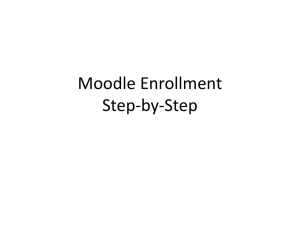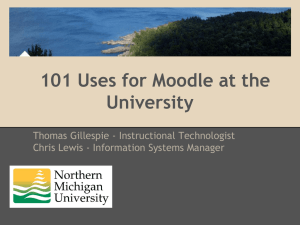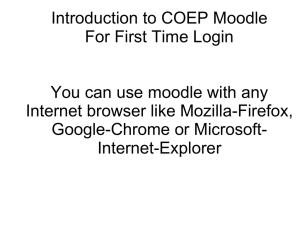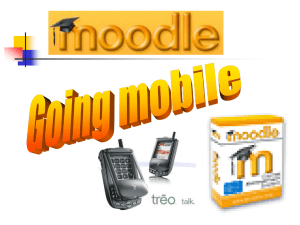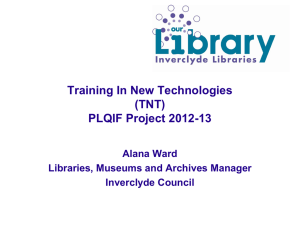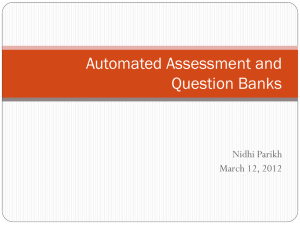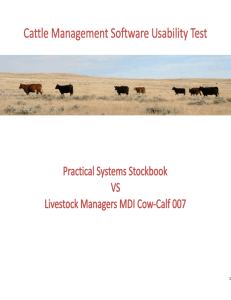Between Pedagogy and Technology: The Pedagogical Affordances
advertisement
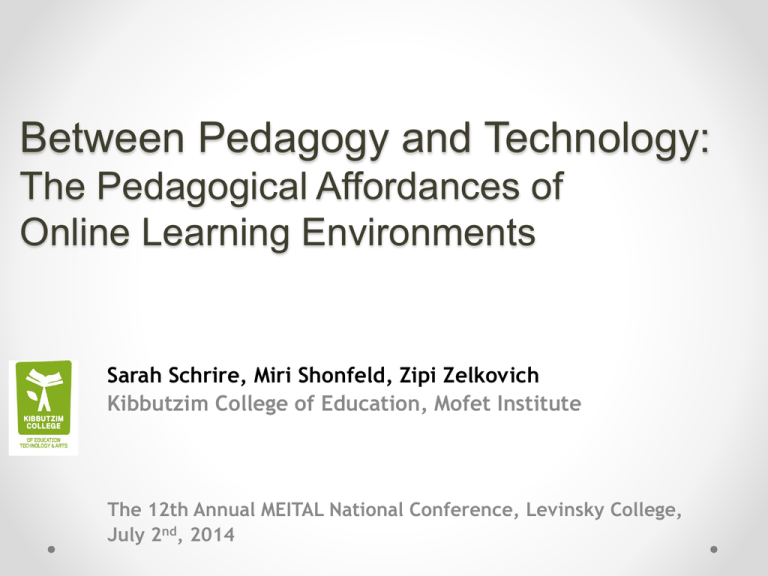
Between Pedagogy and Technology: The Pedagogical Affordances of Online Learning Environments Sarah Schrire, Miri Shonfeld, Zipi Zelkovich Kibbutzim College of Education, Mofet Institute The 12th Annual MEITAL National Conference, Levinsky College, July 2nd, 2014 Theory of Affordances Tools Thinking Change “tools are more than just something to make a task easier. They change your way of thinking, of approaching a task (and indeed the nature of the task itself), and can reap unimagined wider social changes.” Joinson, A. N. (2003). Understanding the psychology of Internet behavior: Virtual worlds, real lives, Hampshire: Palgrave Macmillan, pp. 2-3. Inverting the Question How can ICTs be used to achieve pedagogical objectives? ? (How) do ICTs afford a springboard for conceptualizing new pedagogies? Affordances: Overview Gibson (1970’s) • Ecological theory of perception • Properties of environment in relation to animal behavior Norman (1980’s) • Properties of objects: The Psychology of Everyday Things • Design / perception of computer interfaces Wertsch (1990’s) • Mediating properties of tools Chemero, Hutchby (2000’s) • Explication and redefinition • Relational theory Affordances “Perceiving affordances is placing features, seeing that the situation allows a certain activity” (p. 187). Chemero, A. (2003). An Outline of a Theory of Affordances. Ecological Psychology 15 (2), 181-195. ICTs at the Kibbutzim College: over the years till today Moodle LMS, WordPress CMS, Elluminate for synchronous and recorded lessons 2009-14 2004-09 2000-04 HighLearn LMS, Interwise for synchronous lessons SiteWise for content presentation, Mofet forums and internal mail system for interactivity The Reported Study1 • RQ 1 What…? • RQ 2 In what ways…? • RQ 3 What…? Conducted at the Kibbutzim College of Education with the support of the Mofet Institute Methodology and Analysis • Qualitative o Objectives of the study o Nature of the questions • Mixed-methods technique o o o o Automatically generated reports where available Questionnaires and content analysis (Narralizer) Semi-structured interviews and content analysis Analysis-in-context of sample sites Shkedi, A. (2004). Narralizer Qualitative Analysis Software. Available: http://www.narralizer.com RQ 1 • What characterizes the pedagogical applications of: o each of the asynchronous online environments (SiteWise, HighLearn, Moodle) adopted by faculty? o each of the synchronous online environments (Interwise, Elluminate, Second Life) adopted by faculty? • Designed to define the real affordances of each tool (Norman, 1999, 2004) • Based on the characterizations of each tool by a small expert group • (Is the concept of real affordances a contradiction in terms?) RQ 1 • What characterizes the pedagogical applications of: o each of the asynchronous online environments (SiteWise, HighLearn, Moodle) adopted by faculty? o each of the synchronous online environments (Interwise, Elluminate, Second Life) adopted by faculty? • Zoom-in on Moodle (expert group): o o o o o Learning management Presentation of content (resources, links, etc.) Asynchronous and synchronous interaction Collaborative learning Assignments and tests RQ 2 In ways do do instructors integrate each of of thethe online • what In what ways instructors integrate each online environments in in their pedagogical practice? environments their pedagogical practice? • Questionnaire data • Automatically generated reports of course sites developed on Moodle (2010-2013) • In-depth semi-structured interviews with 14 instructors Asynchronous Activity Types Reported 0 Scanned documents Instruction Pages Worksheets Internet Links Presentations Individual assignments Collaborative assignments Discussions Media Tests Other 10 20 30 40 50 60 70 80 90 Synchronous Activity Types Reported 0 Lecture Student-Pupil Lesson Student-Student Independent Discussion Counseling hour Other 10 20 30 40 50 60 70 80 90 Moodle: Zoom-in Moodle: Zoom-in Moodle: Zoom-in Percentage of Activity Distribution in Moodle: 2010-2013 Moodle: Zoom-in No. of courses with distinctive activity types: 2010-2013 Martin Dougiamas, MoodleMoot, July 2011 Content Analysis of Interviews: Categories • History • Characterization o Time saving o Organization o Encouragement of independent learning • Personal implementation o Efficiency in teaching and learning o Tool as trigger for pedagogical change o Progression in awareness of possibilities and sophistication of use Responses to example questions (How) does the availability of the environment affect your teaching practice? Responses to example questions (How) does the availability of the environment affect your teaching practice? • It enables me to continue the lesson… • To sum up the lesson or open a digital presentation during the lesson itself… • To call up texts • It provides opportunities for the student who is reluctant about speaking – to write • One need not be dependent on catching a student in the corridor since one can raise issues on Moodle. Responses to example questions (How) does the availability of the environment affect your teaching practice? • It enables me to continue the lesson… • To sum up the lesson or open a digital presentation during the lesson itself… • To call up texts • It provides opportunities for the student who is reluctant about speaking – to write • One need not be dependent on catching a student in the corridor since one can raise issues on Moodle. Moodle is my bookcase containing • the syllabus • materials that can be readily available to the learners Moodle Zoom-In: Responses to example questions (How) does the availability of the environment affect your teaching practice? • It enables me to continue the lesson… • To sum up the lesson or open a digital presentation during the lesson itself… Moodle is my bookcase containing • the syllabus • materials that can be readily available to the learners • I had to create a new course and I had the • To call up texts • It provides opportunities for the Moodle topical division helped me to student who is reluctant about conceptualize the topics. speaking – to write • Moodle [interface] in front of my eyes. The • Over the years [using online environments], One need not be dependent on I’ve learned that I have to write precisely catching a student in the corridor what I want to say. In the online since one can raise issues in Moodle. environment, there is no place for correction. • I think at the computer. Moodle Zoom-In: Responses from sample interviews What changed when you adopted a new online LMS? The new environment enables : • the visualization of information • organization of activities • focus • availability of materials • access to online books • I changed from dependence on the content to becoming an independent content developer. • In the past the content was dictated to me and my role was only to activate the forums and chat. RQ 3 • What characterizes the pedagogical approach of instructors who use similar tools within a given online environment? • Two patterns relating to instructors who have maximized their application of the tools: o The “constantly searching” o The “pedagogically already there” • This observation can be connected to the concept of perceived affordances (Norman, 1999, 2004). Emerging answers • We cannot draw conclusions about changes in pedagogical practices but only about reported pedagogical practices • We have learned some things about the ways in which the digital environments are / are not triggering new pedagogical conceptualizations • What is most exciting is identifying the profile of the person who “perceives affordances” in the online environments adopted, who “sees that the situation allows a certain activity” (Chemero, 2003). Return to the theory of affordances Our findings can be explained by the position of Hutchby (2001) in “Technology, Texts and Affordances” • Sees talk of the social impacts of ICTs as “populist discourse” • Raises the issue to a philosophical level: essentialism versus constructivism / interpretivism • Interplay between “essential properties” of technologies and interpretations of those using them Hutchby, I. (2001). Technologies, Texts and Affordances. Sociology 35 (2), 441-456. Return to the theory of affordances Our findings can be explained by the position of Hutchby (2001) in “Technology, Texts and Affordances” • Possibilities for use of a technological object are not infinite; they are socially mediated • Affordances are functional and relational aspects which frame, while not determining, the possibilities of agentic action in relation to an object Hutchby, I. (2001). Technologies, Texts and Affordances. Sociology 35 (2), 441-456. From “Technology, Texts and Affordances” (p. 444) Hutchby, I. (2001). Technologies, Texts and Affordances. Sociology 35 (2), 441-456. Implications / Questions • Pedagogy: What should our vision be in higher education? o Can technology make a difference to pedagogy? o Should we force it to do so? • Practice: How should faculty development programs in ICT integration be structured? • Theory: How does such a study contribute to our understanding of the relationship between texts and technologies? Implications / Questions • Pedagogy: What should our vision be in higher education? o Can technology make a difference to pedagogy? o Should we force it to do so? • Practice: How should faculty development programs in ICT integration be structured? • Theory: How does such a study contribute to our understanding of the relationship between texts and technologies? Thank you for your attention! Sarah Schrire sarah.schrire@gmail.com Miri Shonfeld miri.shonfeld@smkb.ac.il Zipi Zelkovich zipzel@013.net
